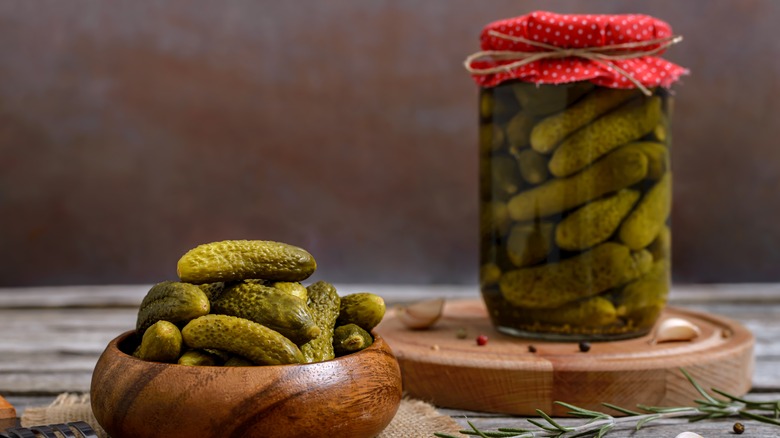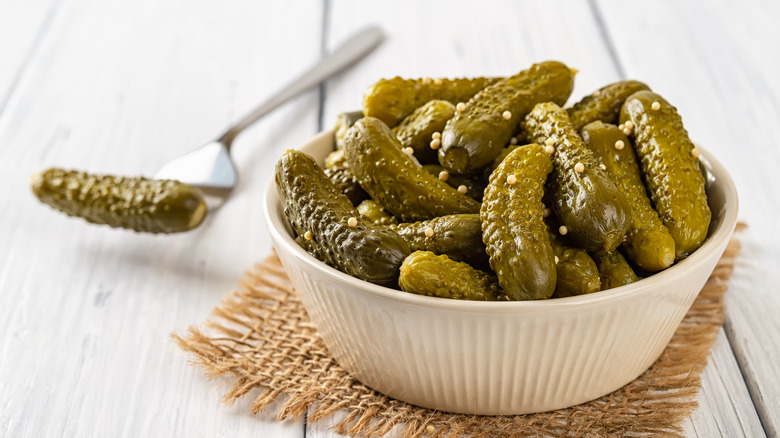What's The Difference Between Pickles And Cornichons?
Triple creams and salumi might be the stars of a stellar charcuterie and cheese board, but the show is not is not complete without a handful of olives and a couple of pickles — specifically tiny gherkins and cornichons. Any good foodie should be able discuss the difference between a speck and prosciutto when it's time to eat, and you shouldn't stop there — get to know the difference between the tasty, tiny pickles on your plate and you can sound like a true culinary pro.
First of all, what is a pickle? Before the days of refrigeration, our ancestors developed pickling as a way to help preserve fresh produce and make it last between growing seasons. You can pickle almost anything by submerging it in a salty and acidic (and sometimes a little sweet) solution, and since the possibilities are endless there is no definitive list of all the different pickles in the world, so it's OK to call anything pickled, simply, a pickle.
There are several types of well-defined pickle varieties, however, from classic dills (full and half sour), to bread and butter chips, to spicy pickled peppers, and, of course, gherkins and cornichons. These two petite pickle types are quite similar in appearance, and actually all cornichons are gherkins, but not all gherkins are cornichons. It all comes down to size and taste.
Gherkins
The term "gherkin" is a little more all-encompassing than just the name of a single variety of pickle. According to Masterclass, the name comes from the Dutch word for small pickled cucumbers — "gurken." Gherkins (Cucumis anguria) are a specific variety of small cucumbers, according to Brittanica, which only grow to about 2 inches long, which is how their pickled brethren got their name. The majority of mass–produced gherkin pickles are made with common cucumbers (Cucumis sativus) that are harvested immaturely, however.
Gherkin pickles are typically between 1 and 5 inches long and are flavored with dill and garlic. They can be either savory or sweet and tend to be bumpier, thinner skinned, and crunchier than full-size cucumber pickles. You can find them either served whole, like with cheese and charcuterie or hanging out with a platter of deviled eggs, on a butter board, chopped up and added to tuna or chicken salad, or used in recipes like pickles and fruit chutney grilled cheese.
These pickles are common, inexpensive, and you can find them in most grocery stores. Additionally, you can also make them yourself by harvesting regular cucumbers from your garden while they are small and pickling them at home with your own herbs and spices. You can even call them gherkins as the term is not specific to any region or style of pickles. Cornichons, on the other hand, are a specialty variety of gherkins that come from France, which like most French delicacies follow more exacting specifications.
Cornichons
So how are cornichons different from gherkins? For starters, cornichons are a French variety of gherkin cucumbers — they're just extra small, according to Specialty Produce. The word "cornichon" means "little horns” in French, and each tiny pickle tops out at around 2 inches long, or about the length and width of a baby's finger. They're common in French produce markets and some of the most popular cultivars are Parisienne Cornichon de Bourbonne, Parigno Cornichon, and Fin de Meaux.
Cornichons are exclusively sour, and are made by salting the tiny fruits overnight and then canning them in jars with vinegar, water, salt and herbs like dill and sometimes tarragon, then left for at least three weeks to ferment (per Specialty Produce). While the name cornichon is not protected by Appellation d'Origine Protegée (AOP) status, which protects food labeling for products from specific regions like Champagne, they are definitely a French specialty food with proprietary recipes. As such, they can be harder to find in regular grocery stores and will be more expensive than gherkins.
Along with sour gherkins, cornichons are pretty interchangeable in recipes, but cornichons are most commonly reserved for dressing up fancier French delicacies like pâté, steak tartare, and raclette (a dish of melted cheese with meat, veggies, and bread or potatoes). They also happen to be the perfect size for garnishing a classic gin or vodka martini for a little bit of a different flavor profile than an olive — take that, negroni sbagliato.


